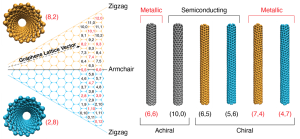Single-walled carbon nanotubes (SWNTs) can be conceptualized as a sheet of graphene rolled into a seamless tube along a specific vector. This vector is known as its graphene roll-up vector and is often denoted by a pair of integers (n,m). Furthermore, this vector dictates the electronic structure and spectroscopic properties of the resulting SWNT. For example, the value of the graphene roll-up l vectors result in the material having either a semiconducting (s-SWNT) or metallic (m-SWNT) electronic structure. A common hurdle when working with SWNTs is that commercially available “enriched” samples are often rather impure. These impurities convolute any photochemical experiments the SWNTs would be used for, as impurities of other SWNT electronic structures may absorb near the target SWNT and complicate spectroscopic assignments. Therefore, aqueous two-phase separation (ATP) of SWNTs is a reliable and valuable method to isolate many different highly enriched single allotrope SWNTs from commercial mixtures. ATP utilizes the variable hydrophobicity of SWNTs, smaller diameter SWNTs have more hydrophilic character than larger diameter SWNTs. This technique employs a biphasic system of polyethylene glycol (PEG) and dextran as a hydrophobic and hydrophilic layer respectively. Another common hurdle when working with SWNTs is that strong Van der Waals forces between SWNTs leads to SWNTs forming large aggregates in the solution phase, which prevents them from being dissolved in aqueous or organic solvents. Organic polymers such as PFO have been shown to suspend individualized SWNTs, however they result in total, unordered coverage of the SWNT surface, making it difficult to study any interactions between external molecules and SWNTs. In order to address this issue, our lab has developed a series of chiral, semiconducting arylene ethynylene polymers that are able to wrap SWNTs in a single-handed helical manner at a fixed helical pitch length. These polymers facilitate solubility of individual SWNTs in both aqueous and organic media, while only covering ~20% of the SWNT surface, leaving the majority of the SWNT exposed to the solvent. Furthermore, SWNT potentiometric properties, exciton binding energies, and ground and excited state energy landscapes can be modulated by the nature of the electronic structure of the semiconducting polymer that wraps its surface.

(A) Schematic illustrating the requisite design for aryleneethynylene polymers that give rise to single-handed helical wrapping of SWNTs. (B) Prototypical chiral semiconducting aryleneethynylene polymer. (C) TEM image highlighting single-chain nanotube wrapping at a fixed helical pitch length. (D) A MD simulation of a chiral polymer wrapping the SWNT surface. (E) AFM image of SWNTs dispersed using PFO in toluene solvent. (F) Nanotubes wrapped by multiple PFO chains, highlighting the heterogeneous nature of these dispersions.
Selected publication: J. Am. Chem. Soc. 2013, 135, 43, 16220–16234.
Contact Riley or Jamie if you’d like to know more about this work.

